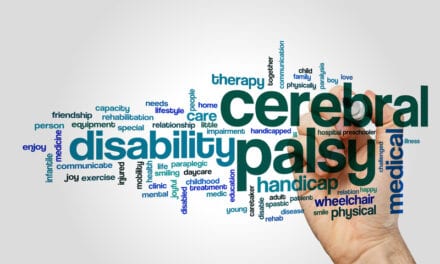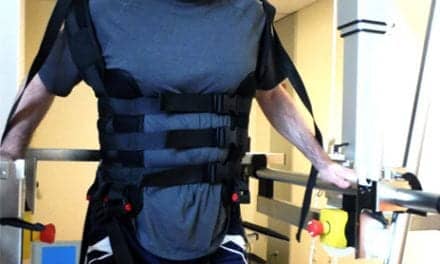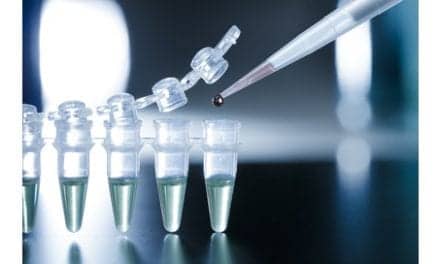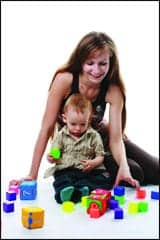 |
| Playing and interacting is an essential daily activity for youngsters. |
The spinal cord communicates sensation and controls movement throughout the body by transporting messages to and from the brain, but when a spinal cord injury (SCI) occurs, communication pathways are disrupted. Once the initial injury has healed, effective rehabilitation helps patients learn skills to live independently with any remaining disability.
Spina bifida is a birth defect typically occurring at the end of the first month of pregnancy that involves the incomplete development of the spinal cord or its coverings. The primary goal of managing the disorder is to prevent infection and further injury to the exposed spinal cord and nerves.
Cerebral palsy (CP) usually results from an injury to the brain, which may interfere with a child’s ability to walk, talk, eat, or play in the same manner as most other kids.
In this article, we will discuss the role of the physical medicine team’s approach—occupational/physical/speech therapist—in helping children with special needs such as SCI, spina bifida, and CP function as well as possible in everyday life.
OCCUPATIONAL THERAPY
“The goal of occupational therapy for children with special needs—and developmental delays, illnesses, or injuries that limit their ability to function independently—should be to improve their self-help skills and adaptive behavior. It depends on what’s involved as to where and what is treated,” according to Cindy Valverde, an occupational therapist (OT) with Florida Easter Seals in Palm Beach County. “With spina bifida, treatment consists of strengthening the upper extremities, dressing, and visual perception skills,” she says.
Children with CP can have a variety of problems or difficulties, depending on the involvement, which may be minimal to severe. Pediatric occupational therapy works on head and trunk control, mobility, positioning, and using the upper extremities, she says. For children with more severe involvement, treatment can consist of passively ranging their joints to prevent contractures and providing sensory input, as the child does not get to explore or move on a regular basis. OTs may recommend special equipment for positioning or home use to assist with their care, such as hardware installed in the home to make it easier to get in and out of the bathtub, or special computers to help a child with very limited mobility turn on a light, speak, or open doors. Orthopedic therapists and PTs can jointly assist in the recommendation of wheelchair equipment.
Children who are less severe may have their therapist work on trunk control and pelvic mobility so they can sit and engage in bilateral hand and fine motor skills. Occupational therapy may also work on increasing their independence in eating with a spoon. In children who are less involved, such as being hemiplegic, an OT may help in increasing the use of their involved arm, with sensory input to increase awareness of their arm while providing bilateral hand skills. Range-of-motion activities and midline play skills, and dressing skills if age appropriate, may also be included, and the OT may work on flexibility issues.
“We may assess for splints for their hands, if needed,” Valverde says. When children reach school age, depending on the severity, the OT may work on their handwriting skills as well.
SPEECH THERAPY
Children with special needs have many issues that may be addressed by speech therapy. “They may have receptive, expressive, or oral motor difficulties … and may not be able to communicate with words or gestures,” says Dani Waters, MS, CCC/SLP, and director of the Children’s Speech Therapy Center, Herndon/ Ashburn, Va.
Activities to help a child with special needs develop appropriate language skills are being playful with the child while naming and playing with toys like balls, bubbles, cars, dolls, blocks, and puzzles. Waters says, “It is helpful to name the objects and actions, such as ‘Let’s roll the ball’ or ‘Blow bubbles.’ ” Everyday activities, such as going to the grocery store, provide great learning experiences.
“[Parents] can talk about the foods and the colors, shapes, smells, and sizes of the foods for the family,” she says. Parents are a child’s information source, so narrating a lot of the interesting things in the child’s world is key. Reading books and singing songs are other ways to stimulate a child’s understanding and expression of language skills. Correct placement of the tongue and lips for certain sounds may also be addressed. Picture boards or computer-based aids can enable children to point to an idea they want to be expressed. Sign language may also come into play if the child is older and has good hand control.
Waters also treats special needs children with hearing loss. She says early detection is critical in making progress with a hearing-impaired child’s language skills. “Auditory training skills are important to get a strong foundation in the world,” she notes. “Children can be instructed with turning their head to a source of sounds, to their name, and, of course, understanding the labels of objects and actions in their environment.”
PHYSICAL THERAPY
As soon as possible after a SCI, for example, therapists will begin range-of-motion and muscle-strengthening exercises, respiratory rehabilitation, pressure reliefs, and proper positioning. These are necessary to thwart physical decline as in contractures, pulmonary complications, and pressure sores. The focus will be on the muscles and joints that will be used to accomplish the best possible functional outcome.
Slow stretching loosens arm and leg muscles. Children with CP often have very tight muscles that need to be worked and relaxed to improve mobility, and they can be taught to practice standing for a specified amount of time each day to enable the hip joints to develop properly. The therapist might use a special stand for the child who can’t stand on their own. Special pillows, knee immobilizers, or supports to help a child sit unassisted can be used to position body parts in ways that contribute to improved movement and growth.
Water therapy is also an option as treatment for CP symptoms. Some therapists find that their patients are able to increase their range of motion through exercises done in a swimming pool. The weightless effect of the water makes it easier to work with tight muscles. It has been demonstrated that aquatic therapy can have beneficial impacts on gross-motor function, self-esteem, and cardiopulmonary functions. The key components are repetition, active movement, warm temperatures, and fun. Therapists use adaptive equipment in the water to help the child feel secure and relaxed.
“Work in the water, against resistance of the water, increases physical fitness in a population where movement experiences may be limited,” says Susan Grosse, MS, of Aquatic Consulting and Education Resource Services, Milwaukee.
“Gravity restricts movement on land, buoyancy facilitates movement in water. That movement also facilitates release of tension and relaxation, which makes a child more independent. Establishing productive exercise habits early on may lead to lifelong maintenance of a healthy lifestyle, which is critical for anyone with a disability,” she adds.
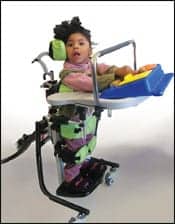 |
| A stander is one of a variety of assistive/adaptive equipment that helps special needs children socialize with peers. |
TYPES OF ASSISTIVE EQUIPMENT
A vast range of assistive and adaptive equipment helps foster independence for children with special needs, helping them to perform daily activities and tasks and socialize with peers. Mobility, standing, bathing, grooming, eating, and speaking can be aided with standers, gait trainers, wheelchairs, strollers, pushchairs, bicycles/tricycles, walkers, leg braces, crutches, swings, bathing accessories, bolsters/rolls, therapy wedges, tables/trays, exercise balls, car seats, and high chairs.
“For kids, an essential daily activity is simply playing and interacting with peers,” says Amy Meyer, PT, ATP, a pediatric and standing specialist. “Standers foster eye-to-eye interaction; they are weight bearing and improve vertical access for reaching items such as light switches and thermostats. Gait trainers promote safety and support with ambulation; and adaptive bathing equipment furnishes appropriate postural support for safety in the tub.”
Standers are increasingly seen as a tool for building strong bones—and the whole-body vibration platform has emerged as a hot trend in standing. “Our concept of what standers are good for is shifting,” says Ginny Paleg, PT. “They help with bone density, and—if you add a vibration platform—they can help with reaching, gross-motor function, posture, and balance.”
To increase bone density, a child needs to use a traditional stander for at least 7 to 10 hours per week, or 4 to 10 minutes per day for a stander with a vibration platform, she says. The stander’s usefulness for decreasing spasticity lasts only a short time—a child who stands for 30 minutes will decrease spasticity for the same duration, she says. Traditional static standing does not significantly enhance stretching, but vibration may help with stretching the hamstrings.
Another new trend, treadmill training with body-weight support, is viewed by many as the best evidence-based practice for restoration of gait. “Body weight-support gait therapy has been shown to restructure the brain in response to concentrated high-frequency intervention,” Paleg says. “When done five times a week, children often show significant progress in 4 to 6 weeks.” She says using a gait trainer over ground provides more practice and can also speed recovery. Other hot trends in gait therapy are passive cycling, and passive cycling with functional electrical stimulation.
Gait trainers help children partake in school activities that would be off-limits without a supported device. “Why stand in the corner and watch the fun when you can get in a gait trainer and be part of the fun?” Paleg says. Several new models of gait trainers aid in walking for children who have no head control, dystonia, or severe asymmetries, and those who refuse to push down to stand upright. Paleg cites a couple of promising new models on the market that allow for maximal active movement; the child can bounce up and down and side to side and do the wiggle with one device; the other device allows a child to squat and transition from sit to stand without fear of falling.
Kevan Craig, DO, medical director and head of the division of Pediatric Rehabilitation Medicine at Children’s Hospital Los Angeles, serves a spectrum of needs for children impacted by all levels of SCI. “Our goal is to make the patient as whole as possible,” he says, citing the aim to restore function as it was before an accident or injury, regardless of age. “Someone with SCI may not be able to walk, but they can use a wheelchair, they can use an elevator or ramps. Kids as young at 4 or 5 can learn how to catheterize, to use a suppository to have a bowel movement—to make them as independent as possible.”
A parapodium stander is often used to help control spasticity and position a child eye-to-eye with others. For patients with paraplegia or incomplete quadriplegia, it is strapped on from the waist to the legs, and a tray or table option helps the child play, complete homework, and interact with others. Walker/swivel walkers help children with upper-torso control move into position. And seating elements are very important for bathing and performing activities of daily living. “Say a girl wants to brush her teeth, comb her hair, put on makeup—she can’t do that lying down; she must sit in a device,” he says.
Manual-assistive devices may be sufficient in many circumstances, but powered assistance may be needed at other times to provide a child with functional independence. “Sometimes powered devices and wheelchair-seat functions are seen as unnecessary for children because they have caregiver assistance available,” Meyer says, with a caveat. “However, settling for a manual device that a child cannot use independently fosters dependency on others and results in learned helplessness. Children should be enabled to fully participate in life as independently as possible.”
A rehab team is essential for prescribing therapeutic devices tailored to each child’s needs. Previous prescriptive patterns for items such as standers were typically 1 hour daily or 2 to 3 times per week, but research is supporting more frequent use with shorter loading duration to boost bone health, Meyer says. Gaining compliance is a constant issue with all types of assistive technology, and ease of use and comfort directly correlate with how frequently items are used. Equipment should generally be used as frequently as possible to keep a child actively and independently participating in daily life. “If the patient is struggling to keep up or fully participate in an activity, maybe an alternative piece of adaptive equipment should be considered,” she says. The formula for finding alternatives may include some trial and error on the part of caregivers, mixed with a dose of expertise. “I often find that some therapists are hesitant, for instance, to recommend powered mobility for fear that a child might become ‘lazy’—therapists often confuse mobility with exercise, and a child would really require power mobility in order to fully participate in their typical daily activities safely and efficiently.”
NEW TECHNOLOGIES
New technologies may also play a role. Eye-gaze technology is successfully being used with computer programs and games, but some cite unresolved issues in its use with mobility. Meyer voiced concerns with its safety for access to power mobility. The field of rehab technology has spawned electrical muscle stimulation, which is garnering attention for treating children with myriad conditions. Several companies offer home electrical stimulation (e-stim) units. Some programs are designed by a therapist, and patients or caregivers receive training for home use; other higher-tech programs are suitable for clinic use only under the supervision of a therapist, such as a robotic gait-training system for SCI patients. Some stationary bikes feature e-stim for the lower extremities while the legs are pedaling. Wheelchairs often feature advanced technology for seating, seat functions, and electronics with high-tech programmability to maximize a child’s independence. Most manufacturers of power wheelchairs offer power-seat functions such as tilt, recline, elevating legrests, seat-elevation systems, standing, and seat-to-floor. One power wheelchair provides seat elevation for increased vertical access and a seating system that lowers the child to the floor, aiding in independent transfers and peer interaction at the floor level for circle time in school or day care, reaching low bookshelves, and feeding pets. Another model, which helps a child stand from a seated or horizontal position, lets the child drive from a standing position.
Access to therapeutic methods, technological advances, devices, and equipment is squarely placing children with special needs face-to-face with their able-bodied peers.
Nina Silberstein is a contributing writer for Rehab Management. For more information, contact .


